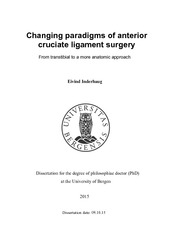| dc.contributor.author | Inderhaug, Eivind | en_US |
| dc.date.accessioned | 2015-11-25T13:10:39Z | |
| dc.date.available | 2015-11-25T13:10:39Z | |
| dc.date.issued | 2015-10-09 | |
| dc.identifier.isbn | 978-82-308-3481-7 | en_US |
| dc.identifier.uri | https://hdl.handle.net/1956/10677 | |
| dc.description.abstract | The current thesis consists of four papers evaluating results after anterior cruciate ligament reconstruction using two different surgical techniques. Paper I and II evaluate long-term outcomes after a transtibial technique using a so-called “antiimpingement” guide for tibial tunnel placement. Clinical examination, patient reported outcome measures and radiographic osteoarthritis/tunnel placement evaluation was performed. Paper III and IV utilized postoperative 3D-CT to evaluate graft tunnel placement in a cohort of patients in the midst of a change from the transtibial technique to an AM-portal (or more anatomic) technique. Femoral tunnel placement was measured relative to an empirical anatomic centre (based on an average native femoral insertion from a range of anatomic studies). Paper I and II found a low revision rate of 4%, good patient reported outcomes (PROMs) – in terms of mean Lysholm score of 89 and mean IKDC subjective score of 83 – and a low prevalence of osteoarthritis. At clinical examination, however, there was a 20% incidence of 2+ pivot shift, indicating a significant failure in restoring native knee kinematics. Further, a 24% incidence of posterior tibial tunnels – defined as 50% or more along the anterior-posterior direction of the tibial plateau – was found to be related to rotatory instability (2+ pivot shift) with associated significant worse outcome in PROMs. Paper III and IV depicted the change in femoral tunnel position from the transtibial technique to the AM-portal technique, with an initial great variation in tunnel positions indicating that ACL remnants and bony landmarks were unreliable for guiding femoral tunnel placement. Further, both the feedback from postoperative CT assessments (Study I) and the use of intraoperative fluoroscopy (Study II) were found to bring the femoral tunnel position closer to an empirical femoral tunnel reference. In sum, Paper I and II adds to the critique of the transtibial technique for femoral tunnel placement and displays that avoidance of overly anterior tibial tunnel placement (by the anti-impingement guide) can lead to a high incidence of posterior tunnel placements. Further, the importance of a multitudinous approach for outcome evaluation is emphasized. Study III and IV shed light on one plausible reason for a learning curve of the AM portal approach for ACL reconstruction. Using per- or postoperative evaluation of tunnel placement can help avoid an unwanted variation in femoral tunnels – but ultimately the results needs to be linked to finite outcome evaluation to establish the clinical impact. | en_US |
| dc.language.iso | eng | eng |
| dc.publisher | The University of Bergen | eng |
| dc.relation.haspart | Paper I: Inderhaug E, Strand T, Fischer-Bredenbeck C, Solheim E. Long-term results after reconstruction of the ACL with hamstrings autograft and transtibial femoral drilling (2013) Knee Surg Sports Traumatol Arthrosc 21:2004-2010. The article is not available in BORA due to publisher restrictions. The published version is available at: <a href="http://dx.doi.org/10.1007/s00167-012-2330-x" target="blank">http://dx.doi.org/10.1007/s00167-012-2330-x</a> | en_US |
| dc.relation.haspart | Paper II: Inderhaug E, Strand T, Fischer-Bredenbeck C, Solheim E. Effect of a too posterior placement of the tibial tunnel on the outcome 10–12 years after anterior cruciate ligament reconstruction using the 70-degree tibial guide (2014) Knee Surg Sports Traumatol Arthrosc 22:1182-1189. The article is not available in BORA due to publisher restrictions. The published version is available at: <a href="http://dx.doi.org/10.1007/s00167-013-2593-x" target="blank">http://dx.doi.org/10.1007/s00167-013-2593-x</a> | en_US |
| dc.relation.haspart | Paper III: Inderhaug E, Larsen A, Strand T, Waaler PA, Solheim E. The effect of feedback from post-operative 3D-CT on placement of femoral tunnels in single-bundle anatomic ACL reconstruction (2016) Knee Surg Sports Traumatol Arthrosc, 24:154-160. The article is not available in BORA due to publisher restrictions. The published version is available at: <a href="http://dx.doi.org/10.1007/s00167-014-3355-0" target="blank">http://dx.doi.org/10.1007/s00167-014-3355-0</a> | en_US |
| dc.relation.haspart | Paper IV: Inderhaug E, Larsen A, Waaler PA, Strand T, Harlem T, Solheim E. The effect of intraoperative fluoroscopy on the accuracy of femoral tunnel placement in single-bundle anatomic ACL reconstruction (2015) Knee Surg Sports Traumatol Arthrosc, 25:1211-1218. The article is not available in BORA due to publisher restrictions. The published version is available at: <a href="http://dx.doi.org/10.1007/s00167-015-3858-3" target="blank">http://dx.doi.org/10.1007/s00167-015-3858-3</a> | en_US |
| dc.title | Changing paradigms of anterior cruciate ligament surgery. From transtibial to a more anatomic approach | en_US |
| dc.type | Doctoral thesis | |
| dc.rights.holder | Copyright the author. All rights reserved | |
| dc.identifier.cristin | 1279411 | |
| dc.subject.nsi | VDP::Medisinske Fag: 700::Klinisk medisinske fag: 750::Ortopedisk kirurgi: 784 | en_US |
